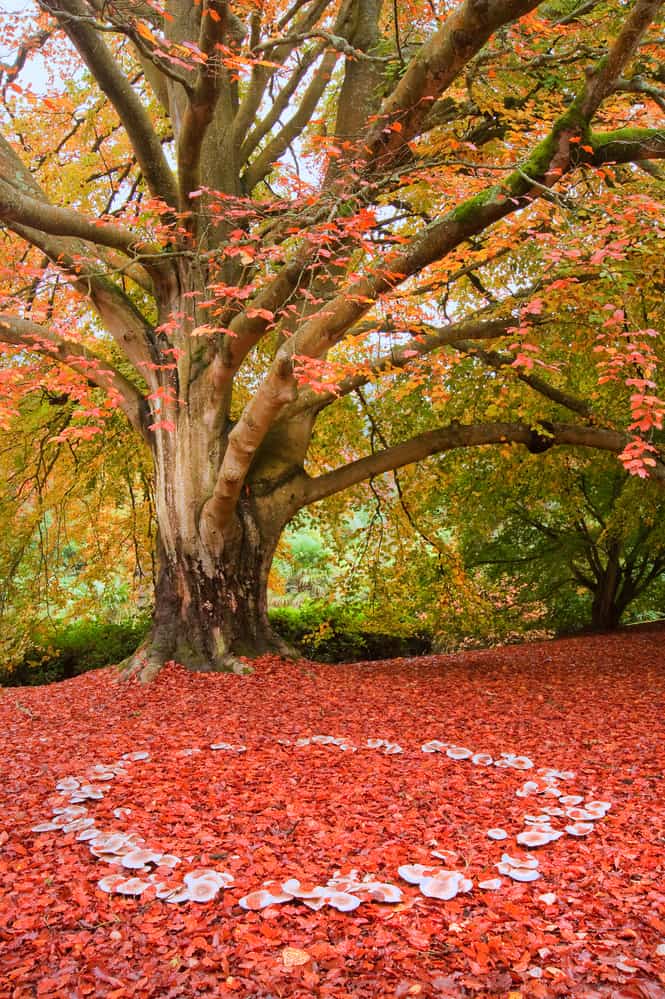The Legend of Fairy Ring Mushrooms
Fairy Rings are a ring or arc of mushrooms formed within the soil that are arranged in an attractive circle (Lepp, 2012). They can be seen growing in your backyard or a wooded area after a heavy rain. Fairy Rings can be perceived as a bit of good luck or a dark omen.
Scientists find Fairy Rings to be a naturally occurring phenomenon (Tarnita, et al., 2017). However, Fairy Rings are a fungal infection. What these Fairy Rings? How they are formed? This article will provide you with the answers to all your questions!

What is a Fairy Ring and why does it form?
The scientific name of Fairy Rings is Marasmius Oreades. They are also known as Fairy Circle, Elf Circle, Elf Rings, Pixie Rings, or Scotch Bonnets (Chambers, et al., 1841, p.55). Some do believe that these are formed by fairies dancing in circles; while some are of the idea that witches use it for the craft.
There are some very interesting stories associated with Fairy Rings. For instance, once you enter the ring, you reach the fairy realm and you may go on dancing until you get exhausted and die. Some believe that Fairy Rings are a portal for fairies to move between the two worlds. The truth behind the rings is seldom known by those who’ve never seen or heard about it.
How do the mushrooms grow in a ring if it’s not something ghostly? These rings occur naturally. There is a single fungus growing underground (mycelium). That fungus sprouts a lot of small threads (hyphae) in a circular shape. After some time, the mushrooms will grow out of the ground at the edge of the circle.
What does a Fairy Ring Mushroom look like?
Fairy Rings can be formed from any type of mushroom from the edible ones to the poisonous ones. It’s very hard to differentiate between the two and it’s better to avoid eating mushrooms found in the wild. However, getting poisoned by wild mushrooms is very common. It can cause mild stomach pain, severe allergic reactions, or fatality.
A Fairy Ring Mushroom or Fairy Ring Champignon grows in clusters and is of both the types, Agaricus campestris (edible) (Linnaeus, 1753) and Chlorophyllum molybdites (poisonous) (Beug, 2004).
Usually, it is defined as a nipple shaped herb, having a reddish-brown cap and off-white gills. It has a straight stalk, dry but smooth texture, and broad gills. They keep increasing in size each year. They can wither in a dry atmosphere but revive quickly after a little rain shower as they need very little water to survive.
May to September is the time you may encounter these rings. These rings may spread from a few inches to 50 meters or even above that. They can be of different ages, too. They have an average life span of 24 years.

What does a Fairy Ring look like?
Fairy rings can be viewed in three different forms (Cummings, 2016). First being, the dark green circles (necrotic zones) with dead grass. The second form being overly grown threads of grass in a circular shape. Lastly, the formation of a circle. These Fairy Rings are either free rings or tethered.
Free rings are normally seen in meadows and lawns. They feed on dead organic material. Tethered Fairy Rings are found in the forests, circling one or more trees. They have a symbiotic relationship with the roots of trees that help them to get nutrients from the soil to feed on.
How do you get rid of a Fairy Ring?
It’s important to note that a Fairy Ring isn’t a serious lawn disease. However, for individuals having a high aesthetic sense, it may be an issue. There are precautions individuals can take to get rid of these unwanted bodies (Damask, 2017).
- Mow grass 2” to 4 “ regularly
- Remove debris around the rings (mushrooms feed on decomposing organisms)
- Clear mushrooms with a hand rake
- Aerate the soil by digging small holes about 6” of depth
- Apply nitrogen fertilizers
- Add fungicide if needed
- Clear fungi
- Irrigate the area well
Keep in mind, it can’t be an easy job every time as they are dependent on the dead soil underneath. They can pop up again and again after the removal, even to a limit of five years. So, you need to dig that affected soil area to the depth of 1.5 feet and leave it filled with topsoil and plenty of water to avoid it in the future.
Watching it for a bit of time will help you sodding for a new plantation. Consider cleaning your gardening tools to prevent the spread.
Are they dangerous?
The folklore of fairy rings can be heard and believed as is passed on to generations. It is widely considered as a sign of otherworldly presences.
Apart from all the magical things you’ve heard about fairy rings, you shouldn’t take risk of using these mushrooms in cooking or for preparing any medicine until you do have a deep knowledge of mushrooms. Many poisonous mushrooms resemble the edible ones.
It would be wiser to remove all mushrooms or puffballs from your lawn as soon as you see them. It would also be wise to keep children away from these mushrooms, too.
How do Fairy Rings spread?
The soil-inhabiting fungi of the class Basidiomycetes are the basic cause of these fairy rings. The mushrooms that are apparent are the fruiting body of the fungus. These fungi can cause development and a massive spread of rings as they release nutrients on which these rings thrive. They generally flourish in hot and dry weather.
According to a study in 2012 (Tschinkel, 2012), the eastern edge of the Namib Desert of Southwestern Africa is considered to be their home. The soil is sandy and the rainfall is between 50 to 100 mm per year.
Fairy Ring fungi break down the organic matter in the soil instead of attacking the grass directly, resulting in the release of nitrogen that facilitates the growth and development of these rings. The mushrooms, producing and containing high levels of hydrogen cyanide, becoming extremely toxic.
Are Fairy Rings dangerous to my pets?
According to veterinarians, fairy rings can be harmful or even deadly to your pets, especially dogs. It’s better to dig out all such fruiting bodies from your lawn and dispose of them properly. If your pet has accidentally eaten a small part of it remove the mushroom from its mouth immediately. Get rid of those rings as soon as possible or if it is not in your lawn, avoid taking your pet in that area.
Sources
Beug, Michael W. An Overview of Mushroom Poisonings in North America. Archived 2010-05-20 at the Wayback Machine The Mycophile, vol. 45(2):4-5, March/April 2004
Chambers’s Edinburgh Journal, Volume 9 by William Chambers, Robert Chamber, W. Orr, 1841, Page. 55
Cummings, Margot. “Fairy Rings.” Wisconsin Horticulture, 2016, hort.extension.wisc.edu/articles/fairy-rings/.
Damask, Tarah. “How to Kill Fairy Ring Mushrooms.” Home Guides | SF Gate, 21 Nov. 2017, homeguides.sfgate.com/kill-fairy-ring-mushrooms-45931.html.
“Fairy Ring Folklore.” Fairy Rings – Fairy Ring Folklore, www.fairyring.ca/fairyringfolklore.html.
Lepp, Heino. “What Is a Fungus ?” What Is a Fungus ?, 26 June 2012, www.anbg.gov.au/fungi/what-is-fungus.html.
Linnaeus C. (1753). Species Plantarum (in Latin). 2. Stockholm: Lars Salvius. p. 1173.
Tarnita, Corina E., et al. “A Theoretical Foundation for Multi-Scale Regular Vegetation Patterns.” Nature News, Nature Publishing Group, 19 Jan. 2017, www.nature.com/articles/nature20801.
Tschinkel WR (2012) The Life Cycle and Life Span of Namibian Fairy Circles. PLoS ONE 7(6): e38056. https://doi.org/10.1371/journal.pone.0038056




